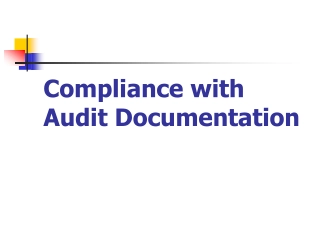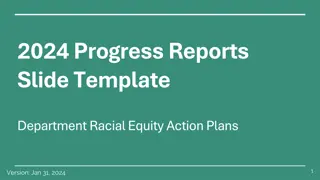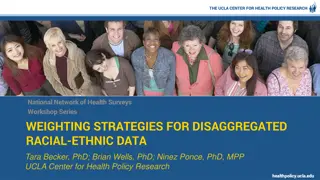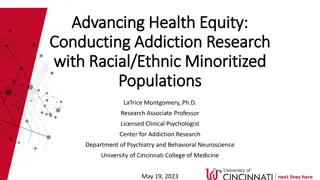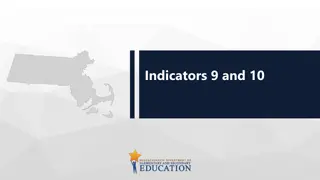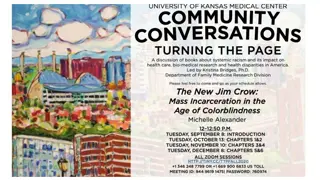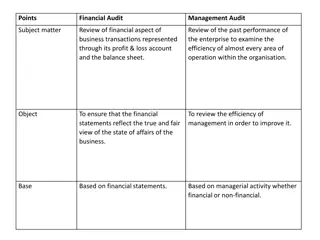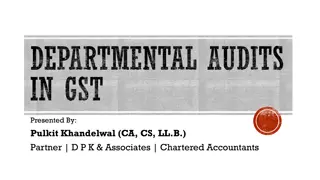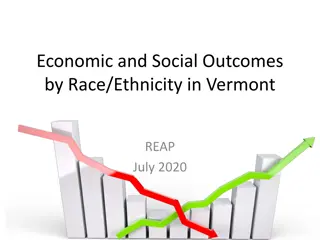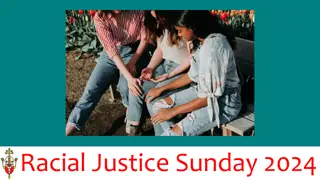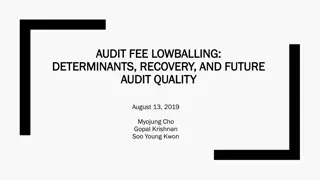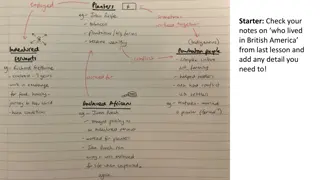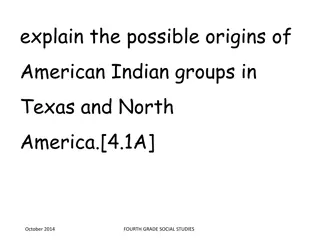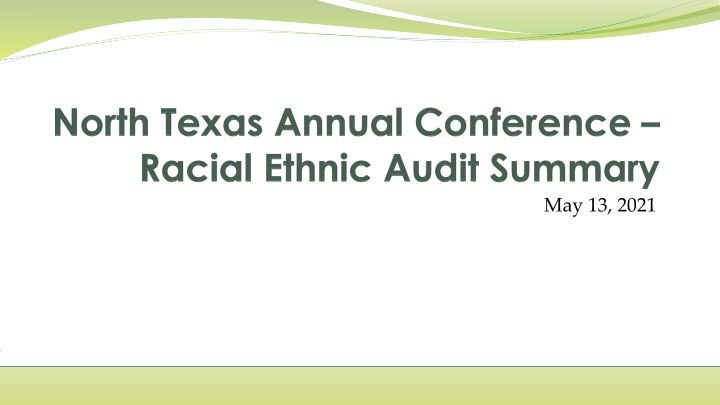
Racial Ethnic Audit Completed by North Texas Annual Conference
Process completed by staff of North Texas Annual Conference involving audit review and discussions with various community representatives. Discussions focused on demographic disparities and strategies to increase diversity and outreach in ethnic communities within the conference.
Download Presentation

Please find below an Image/Link to download the presentation.
The content on the website is provided AS IS for your information and personal use only. It may not be sold, licensed, or shared on other websites without obtaining consent from the author. If you encounter any issues during the download, it is possible that the publisher has removed the file from their server.
You are allowed to download the files provided on this website for personal or commercial use, subject to the condition that they are used lawfully. All files are the property of their respective owners.
The content on the website is provided AS IS for your information and personal use only. It may not be sold, licensed, or shared on other websites without obtaining consent from the author.
E N D
Presentation Transcript
Process Racial Ethnic Audit Completed by staff of North Texas Annual Conference 6 Groups reviewed the completed Audit and participated in discussions: Extended cabinet Journey to Racial Justice committee members Representatives from the Asian American/Pacific Islanders community Representatives from Black/African American community Representatives from the LatinX community Representatives from the Rural communities
Discussions Each group was asked questions about the audit. Why do you think the numbers are the way they are? What is most surprising? Concentrated primarily around four areas demographics vs local church, extended cabinet/conference office, clergy, and leadership.
Summary of Discussions DEMOGRAPHIC OF MISSION FIELD AND LOCAL CHURCH MEMBERSHIP The conference needs to create and communicate an intentional plan to increase memberships in ethnic communities so the conference will look like its mission field. The conference needs to create a system to support smaller, low-income, and ethnic churches to grow and thrive. Assist local churches to grow, specifically reflecting their neighborhood s demographics.
Examples We do not reflect our mission field. We have not prioritized in reaching out to our mission field. Need to be able to cultivate the gospel in culturally effective ways and not neglect those of lesser income. Local churches need to interact with their community, especially when their community does not look like them. Very hard for people to continue attending a church if no one looks like them in leadership or in the congregation.
Examples People will go where their needs are met, regardless of what the church looks like. If we do not start now, we will have this conversation again in 10 years. Need to defund, reclaim, and reinvest. If the conference is serious, the conference needs to make an investment with financial resources. Provide equity we keep the big churches big and small churches small. There is much growth to be had. What can we do as a conference to reach Native Americans, Hispanic, Asians, and Black people? Assure them that they have a place here in the UMC.
Summary of Discussions EXTENDED CABINET/CONFERENCE STAFF Cabinet, extended cabinet, conference office should reflect the mission field. The representation on the Cabinet will help guide the conference in the mission field and into a future with more diversity in the population. District Superintendents learn and understand the needs of the Clergy of Color and ethnic churches in their districts. This will help in leadership development and appointment making. Bishop and cabinet can show support for racial justice by making statements when there is a racial incident and participating in racial/ethnic social justice events. Appointments be intentional about appointments with Clergy of Color, more cross racial appointments, do not assume Clergy of Color only wants to go to ethnic churches, appoint clergy reflective of the missional area of the church, not the membership of the church. For Clergy of Color - Provide leadership opportunities and show support and encouragement.
Examples DS needs to be more educated in their areas and get to know the churches and pastors of color in your area. Need to have more cross-cultural appointments so barriers can be broken. There is a norm in the cabinet one Black/African American on cabinet, and/or one woman. That is part of our DNA. Conference has a single story which is white leadership, very difficult to see any other type of leadership. Cabinet should sit down with each group to hear concerns, to discuss racial justice. Foundation of the conference is white. Intentional means installing different ethnicities in leadership roles first and we grow from there.
Examples Need to be intentional to raise leadership in the communities of color to give resources and opportunities. Want Cabinet to support racial justice outside the church walls with those who are advocating. Cabinet needs to have courage to send Clergy of Color to white churches and offer support to the clergy. Leadership should reflect missional area, not church membership. Conference needs the diversity to push diversity. Bishop and Local Churches need to have a conversation about what effectiveness means especially when there is Clergy of Color in white church.
Summary of Discussions CLERGY/PASTORS There is a need for more Clergy of Color, and support from conference is needed for Clergy of Color. Need to learn what is meant by support. Equity among clergy members including salary, appointments. White clergy needs to talk about racism, racial justice and inclusion in their churches and pave the way for their churches to be open and accepting of a Clergy of Color. Clergy needs to strive to have a membership that is reflective of their mission area. Learn more about the needs of Local Pastors.
Examples White clergy leadership in white churches are very important to accepting clergy of color in the church. Not all People of Color want to plant a church in their own community, some want to be in local churches, some want to be in cross cultural appointments. There seems to be no desire to ordain People of Color and even encouraging People of Color to look at other conferences. There is a negative connotation for anything different from white people during the ordination. Clergy rarely talk about inclusion at their churches. Clergy are the leaders who have responsibility for doing this work. There is racism in our conference.
Examples Clergy needs to play the game. Politics is a huge piece. You need to know the right people to get into the club . Only certain people can know the right people. Clergy need to be very careful of what they say about social justice. Can we make it easier for local pastors to become members of Annual Conference? Conference needs to give focus on Local Pastors. Should local church leadership reflect church neighborhood demographics instead of church demographics? Equity and pay. Regardless the size of the congregation, it boggles the mind that there is so much inequity. We should be about gifts and graces. Salary cap? Sharing the funds for salary. Every clergy member of this conference should be teaching diversity and inclusion in the church. Clergy should be inviting clergy women and clergy of color in the pulpit.
Summary of Discussion LEADERSHIP OF THE ANNUAL CONFERENCE Need to have an intentional and strategic plan for more chairpersons and committee members to be People of Color, including having information about the committee and job descriptions of roles in various languages easily available. Reimbursement policy for ALL members of a committee for travel expenses. An intentional effort needs to be made for meetings to be more accessible to all members of the conference, for example, virtual meetings or meetings in a location that is equally distanced from the members, language translation.
Examples There is a lack of representation of People of Color in the leadership of the annual conference, and because there is a lack of representation, it makes it hard to get People of Color interested in leadership positions. Language - Information provided in English (written or spoken). There is a language barrier. Provide information in more than one language, especially on the website. It seems that the conference only wants English speakers. To me, there are different set of expectation for different people depending on their ethnicity. For example, if a white person name is lifted, there may not be a question to his/her qualifications, but when a Person of Color is lifted, there are questions to his or her qualification. Need to have committee information and job descriptions for each committee on the website for people to read and understand what each committee does and the process of getting into the nominating pool.
Examples Intentional about recruitment of people on committees, explaining the procedures of getting on to a committee, the expectations of being on a committee. Economics it cost money to participate. Are people reimbursed for expenses to go to meetings? All members should be offered reimbursement so people will not be embarrassed to ask. For some laity, it is a long drive to where the committee meetings are held. Having virtual meetings this past year has been helpful. Committee meetings are not held at a central location, normally in Plano. People of Color is needed to lead committees, especially committees with power Board of Ordained Ministries, Committee on Episcopacy, Board of Trustees, Finance.
Summary of Discussion GENERAL INFORMATION North Texas Conference needs to be intentional in becoming more diverse, to reflect its mission field. How? What actions will it take? White Local Churches How can local churches become more diverse and engage in anti-racism conversations? How can it resemble the demographics of its neighborhood? How can it be open and inviting to a cross racial appointment? How can wealthier local churches support local churches who are having financial challenges? What systems exist in the North Texas conference that is not helpful to becoming a more inclusive conference? BOOM need to examine its practices and procedures. Nomination Cmt need to examine its practice and procedures. Conference budget how does it show its commitment to racial justice?
Examples People of Color tend to mute themselves and not trust the system because of the way they are treated when they speak their truth. The numbers reflect systemic racism. It may not be intended but real. The UMC is perceived to be a White Church. If the conference cuts finances regarding training for clergy and laity on inclusion, it reflects the lack of priority this conference has on it. This conference is very segregated. White folks think their way is the right way, not even open to there can be more than their way. Politics plays a huge part of this conference. When racism comes up, white people think we are calling them racist. It is hard to have a conversation. Make Ethnic Ministries part of the church, not mission ministry.
Examples The conference only funds things white people need or understand. Support local churches to thrive not just to survive. A DS chairs Nominations Committee and it seems is very political. In BOOM/DCOM, Candidates of Color are asked different questions compared with white candidates. Each ethnic group are asked different questions. White people need to talk about racism, real conversations, this church is divided. We need to figure out ways to communicate.
Examples Racial justice - How do we share money within the conference? What is the plan for churches on life support? Economic disparity. BOOM need more intentionality of diverse clergy. Play with apportionment to get churches to reach diversity goals. Churches who have cross racial appointments will be healthier in the future. How do we prepare churches in all districts? It seems easier for white people to connect with conference than People of Color. Need to make the conference more accessible.
Suggestions People of all backgrounds need to work together to find solutions. Need a sense of unity, a body of believers working together. There needs to be conference lead discussion with people from all backgrounds to listen/hear to each other, to understand one another, to see each other struggles and stories. Not to just get one s own point across and deaf to others. Need to educate churches of color more about the UMC structure to understand how the local church, conference, and denomination functions. Finance - Churches of Color need financial support from the annual conference. Many times, people who attend churches of color sends money back to their family in another country. These churches do not have the financial stability to thrive. Can there be a partnership between these churches with those in the conference that are more financially stable?
Suggestions Focus on younger people high school. Waiting until 18 20+ is too late because they are in their career mode already. Change the apportionment system reward/give incentives to churches that become more diverse with less apportionment. If churches give to mission (churches within the connection), then apportionment goes down. Standing diversity council should be created to ensure progress is being made. Still have a history of systemic racism. Need education of different ways to be spiritual, not only one way.
Next Steps The Cabinet and Journey to Racial Justice Committee will review the Summary. They will make recommendations. At Annual Conference, a report will be given on the Racial Ethnic Audit.

